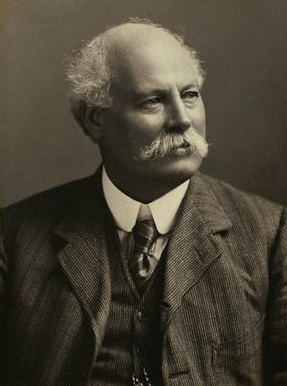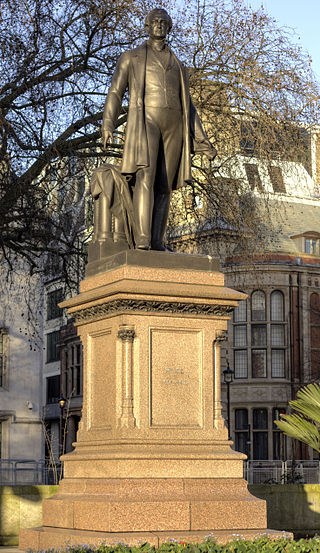
Sir Joseph Edgar Boehm, 1st Baronet, was an Austrian-born British medallist and sculptor, best known for the "Jubilee head" of Queen Victoria on coinage, and the statue of the Duke of Wellington at Hyde Park Corner. During his career Boehm maintained a large studio in London and produced a significant volume of public works and private commissions. A speciality of Boehm's was the portrait bust; there are many examples of these in the National Portrait Gallery. He was often commissioned by the Royal Family and members of the aristocracy to make sculptures for their parks and gardens. His works were many, and he exhibited 123 of them at the Royal Academy from 1862 to his death in 1890.

Parliament Square is a square at the northwest end of the Palace of Westminster in the City of Westminster in central London, England. Laid out in the 19th century, it features a large open green area in the centre with trees to its west, and it contains twelve statues of statesmen and other notable individuals.

Sir Thomas Brock was an English sculptor and medallist, notable for the creation of several large public sculptures and monuments in Britain and abroad in the late nineteenth and early twentieth centuries. His most famous work is the Victoria Memorial in front of Buckingham Palace, London. Other commissions included the redesign of the effigy of Queen Victoria on British coinage, the massive bronze equestrian statue of Edward, the Black Prince, in City Square, Leeds and the completion of the statue of Prince Albert on the Albert Memorial.

John Henry Foley, often referred to as J. H. Foley, was an Irish sculptor, working in London. he is best known for his statues of Daniel O'Connell in Dublin, and of Prince Albert for the Albert Memorial in London.

Lieutenant-General Sir James Outram, 1st Baronet was a British general who fought in the Indian Rebellion of 1857.

Matthew Noble was a leading British portrait sculptor. Carver of numerous monumental figures and busts including work memorializing Victorian era royalty and statesmen displayed in locations such as Westminster Abbey, St. Paul's Cathedral and in Parliament Square, London.

The Victoria Embankment Gardens are a series of gardens on the north side of the River Thames between Blackfriars Bridge and Westminster Bridge in London.

The equestrian statue of Charles I at Charing Cross, London, is a work by the French sculptor Hubert Le Sueur, probably cast in 1633. It is considered the central point of London.

The Shaftesbury Memorial Fountain, officially and popularly known as Eros, is a fountain surmounted by a winged statue of Anteros, located at the southeastern side of Piccadilly Circus in London, England. Moved after the Second World War from its original position in the centre of the circus, it was erected in 1892–93 to commemorate the philanthropic works of The 7th Earl of Shaftesbury, the Victorian politician and philanthropist, and his achievement in replacing child labour with school education. The fountain overlooks the south-west end of Shaftesbury Avenue, also named after the Earl.

The statue of James II is a bronze sculpture located in the front garden of the National Gallery in Trafalgar Square, London, United Kingdom. Probably inspired by French statues of the same period, it depicts James II of England as a Roman emperor, wearing Roman armour and a laurel wreath. It originally also depicted him holding a baton. It was produced by the workshop of Grinling Gibbons. The execution was most likely, according to contemporary accounts, the work of the sculptors Peter van Dievoet from Brussels and Laurens van der Meulen from Mechlin, rather than of Gibbons himself. The statue has been relocated several times since it was first erected in the grounds of the old Palace of Whitehall in 1686, only two years before James II was deposed.

Boadicea and Her Daughters is a bronze sculptural group in London representing Boudica, queen of the Celtic Iceni tribe, who led an uprising in Roman Britain. It is located to the north side of the western end of Westminster Bridge, near Portcullis House and Westminster Pier, facing Big Ben and the Palace of Westminster across the road. It is considered the magnum opus of its sculptor, the English artist and engineer Thomas Thornycroft. Thornycroft worked on it from 1856 until shortly before his death in 1885, sometimes assisted by his son William Hamo Thornycroft, but it was not erected in its current position until 1902.

The statue of Robert Peel in Parliament Square, London, is a bronze sculpture of Sir Robert Peel, a former Prime Minister of the United Kingdom. It was sculpted by Matthew Noble and was one of the first three statues to be placed in the square.

The Emmeline and Christabel Pankhurst Memorial is a memorial in London to Emmeline Pankhurst and her daughter Christabel, two of the foremost British suffragettes. It stands at the entrance to Victoria Tower Gardens, south of Victoria Tower at the southwest corner of the Palace of Westminster. Its main feature is a bronze statue of Emmeline Pankhurst by Arthur George Walker, unveiled in 1930. In 1958 the statue was relocated to its current site and the bronze reliefs commemorating Christabel Pankhurst were added.

A statue of Robert Raikes, often regarded as being the founder of Sunday schools, executed by the sculptor Thomas Brock, stands in Victoria Embankment Gardens, London, United Kingdom. It was unveiled by the Earl of Shaftesbury on 3 July 1880 and marked the centenary of the opening of the first Sunday school. The critic Edmund Gosse considered the statue to be "as good as anything of the kind we possess in England". In 1958 it was designated a Grade II-listed building.

The Thames Ditton Foundry was a foundry in Thames Ditton, Surrey, which operated from 1874 to 1939 and which under various owners produced numerous major statues and monuments as one of the United Kingdom's leading firms of bronze founders.
















